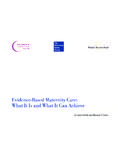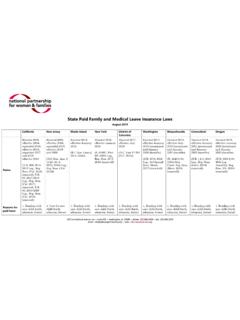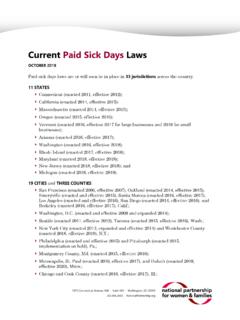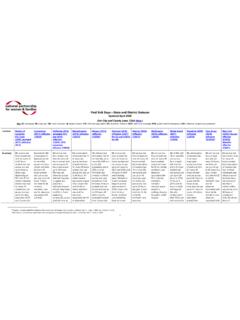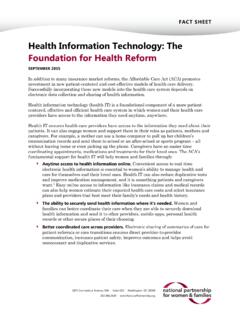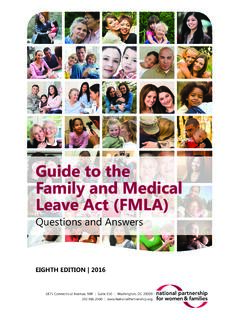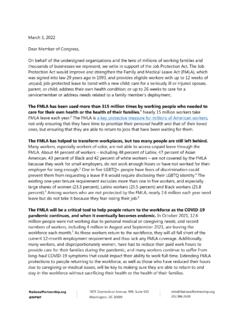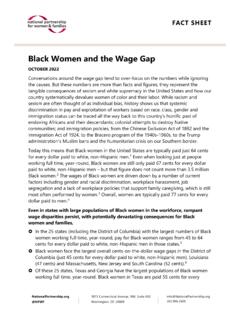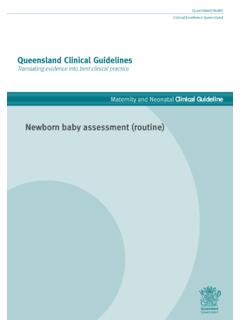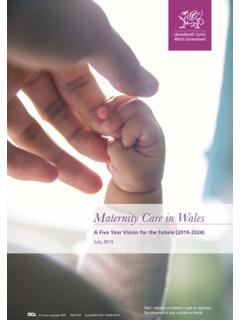Transcription of Evidence-Based Maternity Care: What it is and What it can ...
1 By Carol Sakala and Maureen P. CorryEvidence-Based Maternity Care: What It Is and What It Can AchieveEvidence-Based Maternity Care: What It Is and What It Can AchieveChildbirth ConnectionReforming States GroupMilbank Memorial Fundby Carol Sakala and Maureen P. CorryMilbank Memorial Fund645 Madison AvenueNew York, NY 10022 The Milbank Memorial Fund is an endowed operating foundation that engages in nonpartisan analysis, study, research, and communication on significant issues in health policy. In the Fund s own publications, in reports, films, or books it publishes with other organizations, and in articles it commissions for publication by other organizations, the Fund endeavors to maintain the highest standards for accuracy and fairness.
2 Statements by individual authors, however, do not necessarily reflect opinions or factual determinations of the Fund. 2008 Milbank Memorial Fund. All rights reserved. This publication may be redistributed electronically, digitally, or in print for noncommercial purposes only as long as it remains wholly intact, including this copyright notice and disclaimer. Printed in the United States of America. ISBN 978-1-887748-70-4 This report is printed on paper containing recycled fiber that is certified by the Forest Stewardship Council, which promotes environmentally responsible, socially beneficial, and economically viable management of the world s forests. Cert no. SGS-COC-003288 List of Tables, Figures, and Sidebars.
3 IvForeword .. viiExecutive Summary .. 1 Introduction .. 7 Maternity Care in the Health Care System: Prominent Position, Large Expenditures, Troubling 10 Evidence-Based Maternity Care: Effective Care with Least Harm .. 21 The Physiologic Foundation of Evidence-Based Maternity 25 Overused Interventions: Examples of Practices to Use Judiciously and with Careful Attention to Informed Consent .. 35 Underused Interventions: Examples of Practices to Use Whenever Possible and Appropriate ..51 Challenges to Closing Evidence-Practice Gaps in Maternity Care in the United States ..59 Policy Recommendations Developed in Collaboration with Members of the Reforming States Group.
4 68 Appendix: Leading Resources and Tools for Evidence-Based Maternity Care .. 71 References ..73 The Authors .. 110 Selected Publications of the Milbank Memorial Fund .. 112 Selected Publications of Childbirth 114table oF contentStableS1 Leading Procedures Billed to Medicaid and Private Insurance Payers, United States, 2005 .. 132 Performance on Selected Indicators of Maternal and Newborn Health, United States, Each State, and District of Columbia .. 183 Childbirth in Hospitals, 2005: Listening to Mothers II Survey .. 274 Intervention Rates for Low-Risk Women in the United States and among Births Attended by Certified Professional Midwives, 2000 .. 29 FigureS1 Leading Major Diagnostic Categories by Number of Hospital Discharges, United States, 2005.
5 102 Percentage of Pregnancy, Childbirth, and Puerperium and All-Condition Hospital Discharges by Payer, United States, 2005 .. 113 Total Hospital Charges by Payer, United States, 2005 .. 124 Average Facility Labor and Birth Charge by Site and Mode of Birth, United States, 2003 2005 .. 155 Preterm Birth Rate and Low Birthweight Rate, United States, 1981 2006 .. 166 Total Cesarean, Primary Cesarean, and Vaginal Birth after Cesarean (VBAC) Rates, United States, 1989 2006 .. 42 SidebarSWhat Is the Gold Standard for Knowledge about Effects of Maternity Care? .. 22 National Midwifery Credentials: Certified Nurse-Midwife, Certified Midwife, and Certified Professional Midwife.
6 30 Diethylstilbestrol (DES) Clarifies Importance of Caution with Perinatal Exposures .. 33Is the Most Resource-Intensive Care the Best Care? .. 45 The Evidence about Vaginal Birth after Cesarean (VBAC) .. 57liSt oF tableS, FigureS, and SidebarSCC, RSG, MMFivEvidence-based Maternity care uses the best available research on the safety and effectiveness of specific practices to help guide Maternity care decisions and to facilitate optimal outcomes in mothers and newborns. Although the field of pregnancy and childbirth pioneered Evidence-Based practice, resulting in a wealth of clear guidance for Evidence-Based Maternity care, there remains a widespread and continuing underuse of beneficial practices, overuse of harmful or ineffective practices, and uncertainty about effects of inadequately assessed practices.
7 In order to inform coverage and clinical policy decision making for Maternity care, Childbirth Connection (CC), the Reforming States Group (RSG), and the Milbank Memorial Fund (MMF) collaborated to write, review, and publish this report. The report presents a discussion of current Maternity care in the health care system and identifies key indicators that show the need for improvement. The report further summarizes results of the many systematic reviews that could be used to improve Maternity care quality, identifies barriers to the use of Evidence-Based Maternity care, and offers policy recommendations and other strategies that could lead to wider implementation of evidenced-based Maternity care in the United States.
8 These Maternity care quality concerns and opportunities for improvement are not widely recognized at this time. Organized in 1992, the RSG is a voluntary association of leaders in health policy in the legislative and executive branches of government, from all fifty states, Canada, England, Scotland, and Australia. The Milbank Memorial Fund is an endowed national foundation, established in 1905, that works with decision makers in the public and private sectors to carry out nonpartisan analysis, study, and research on significant issues in health policy. Established in 1918, Childbirth Connection (formerly Maternity Center Association) is a national not-for-profit voice for the needs and interests of childbearing families.
9 Its mission is to improve the quality of Maternity care through research, education, advocacy, and policy. Many members of the RSG, as well as others knowledgeable in the field, reviewed successive drafts of this report. As a result of these reviews and the authors subsequent revisions, we believe that the information in this report is timely and accurate. The matters that have been highlighted by the authors do not necessarily represent the policy preferences of all the members of the RSG or of the other individuals who reviewed drafts of this report. We thank all who participated in this CodyChair, Health Care and Wellness CommitteeWashington House of RepresentativesCo-Chair, Reforming States Group ForewordvCC, RSG, MMFK evin ConcannonFormer DirectorIowa Department of Human ServicesPast Co-Chair, Reforming States GroupJohn NilsonMember of the Legislative Assembly Province of SaskatchewanCo-Chair, Reforming States GroupMaureen P.
10 CorryExecutive DirectorChildbirth ConnectionCarmen Hooker OdomPresidentMilbank Memorial FundCC, RSG, MMFviacknowledgmentSOur sincere thanks to those who generously contributed to this report. They are listed in the positions they held at the time of their participation. The following members of the Reforming States Group demonstrated initial and continuing enthusiasm, helped us set a direction, and worked with us to increase the utility of the report for policymakers: Laurie Monnes Anderson, Chair, Health Policy and Public Affairs Committee, Oregon Senate; Lee Greenfield, Senior Policy Advisor, Hennepin County Department of Human Services and Public Health; Toni Nathaniel Harp, Chair, Committee on Appropriations, Connecticut Senate; Pamela S.
